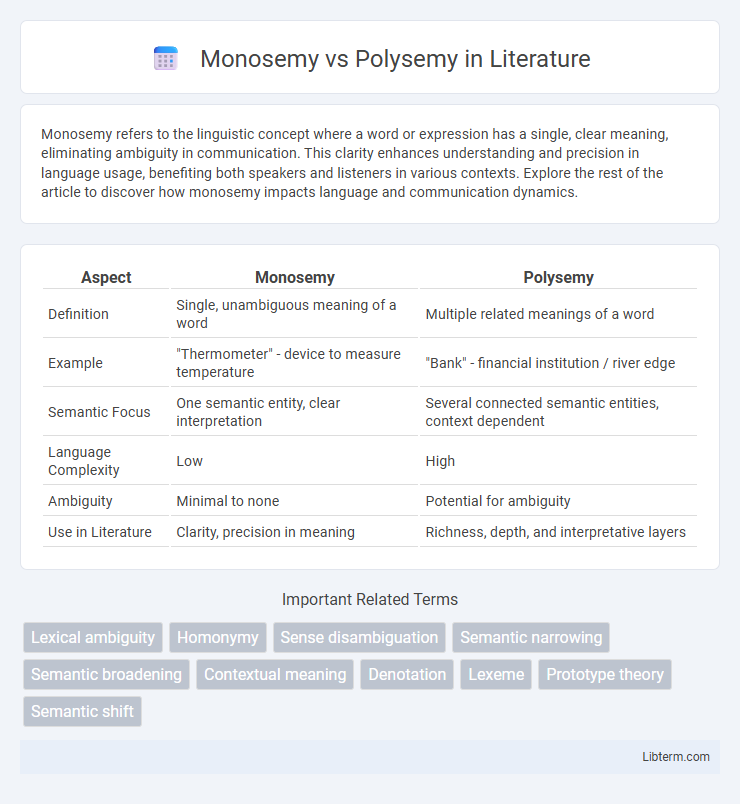Monosemy refers to the linguistic concept where a word or expression has a single, clear meaning, eliminating ambiguity in communication. This clarity enhances understanding and precision in language usage, benefiting both speakers and listeners in various contexts. Explore the rest of the article to discover how monosemy impacts language and communication dynamics.
Table of Comparison
| Aspect | Monosemy | Polysemy |
|---|---|---|
| Definition | Single, unambiguous meaning of a word | Multiple related meanings of a word |
| Example | "Thermometer" - device to measure temperature | "Bank" - financial institution / river edge |
| Semantic Focus | One semantic entity, clear interpretation | Several connected semantic entities, context dependent |
| Language Complexity | Low | High |
| Ambiguity | Minimal to none | Potential for ambiguity |
| Use in Literature | Clarity, precision in meaning | Richness, depth, and interpretative layers |
Introduction to Monosemy and Polysemy
Monosemy refers to a linguistic phenomenon where a single word has only one distinct meaning, ensuring clarity and precision in communication. Polysemy occurs when a single word possesses multiple related meanings, often context-dependent, which enriches language but can lead to ambiguity. Understanding the distinction between monosemy and polysemy is crucial for fields such as semantics, lexicography, and natural language processing.
Defining Monosemy: Single Meaning Words
Monosemy refers to words that have a single, clear meaning within a specific context, eliminating ambiguity in communication. These single meaning words facilitate precise understanding by ensuring that the term consistently relates to one concept or referent. In linguistic analysis, monosemy contrasts with polysemy, where multiple related meanings create varied interpretations of the same word.
Exploring Polysemy: Words with Multiple Meanings
Polysemy refers to a single word possessing multiple related meanings, which often arise from metaphorical or contextual extensions within language. Understanding polysemous words enhances semantic analysis by revealing how context influences meaning interpretation in communication. This linguistic phenomenon contrasts with monosemy, where words maintain only one fixed meaning regardless of usage.
Historical Development of Monosemy and Polysemy
The historical development of monosemy and polysemy reflects evolving linguistic theories where monosemy initially dominated as the preferred model, emphasizing single-meaning words for clarity in communication. The rise of polysemy gained momentum in the 20th century, driven by semantic studies recognizing the context-dependent nature of meaning in language. This shift acknowledges that many words possess multiple related senses, enriching the understanding of lexical semantics and cognitive linguistics.
Cognitive Aspects: How the Mind Handles Word Meanings
The cognitive processing of monosemy involves straightforward activation of a single, stable meaning, enabling quicker comprehension and less ambiguity in language tasks. In contrast, polysemy requires the brain to navigate multiple related meanings, engaging semantic networks and context evaluation to disambiguate word sense effectively. Neuroimaging studies reveal differential activation patterns, with polysemous words eliciting greater engagement in the prefrontal cortex and temporal regions that support semantic integration and contextual inference.
Monosemy vs Polysemy in Different Languages
Monosemy refers to words with a single, unambiguous meaning, while polysemy involves words that have multiple related meanings. In languages like Finnish and Turkish, monosemy is more common due to strict morphological rules that limit ambiguity, whereas languages such as English and Chinese exhibit higher polysemy because of historical language development and lexical borrowing. Understanding the balance between monosemy and polysemy across languages is crucial for accurate natural language processing and machine translation systems.
Impact on Lexicography and Dictionary Compilation
Monosemy, where a word has a single meaning, simplifies lexical entries, enabling lexicographers to provide clear, unambiguous definitions that enhance user comprehension in dictionary compilation. Polysemy, characterized by multiple related meanings of a single word, requires lexicographers to accurately distinguish and organize senses, increasing complexity in dictionary structure and sense disambiguation. Effective management of polysemous words is critical in lexicography to improve dictionary usability and facilitate precise semantic retrieval for language learners and researchers.
Implications for Language Learning and Translation
Monosemy, where a word has a single meaning, simplifies language learning and translation by reducing ambiguity and enhancing clarity in vocabulary acquisition. Polysemy, characterized by multiple related meanings for a single word, poses challenges for learners and translators due to context-dependent interpretation and semantic nuance. Understanding these distinctions improves language proficiency, translation accuracy, and effective communication in multilingual contexts.
Applications in Natural Language Processing
Monosemy refers to words with a single meaning, while polysemy involves words with multiple related senses, posing challenges for word sense disambiguation (WSD) in natural language processing (NLP). Accurate identification of polysemous word senses enhances machine translation, information retrieval, and sentiment analysis by reducing ambiguity and improving context understanding. Leveraging semantic embeddings and context-aware models like BERT significantly boosts performance in handling monosemy and polysemy in NLP applications.
Conclusion: Significance in Linguistic Studies
Monosemy and polysemy play crucial roles in understanding word meaning and language structure, influencing semantic theory and lexicography. Monosemy offers clarity in lexical representation, while polysemy reveals the dynamic and context-dependent nature of meaning. These concepts are fundamental for computational linguistics, natural language processing, and effective communication analysis.
Monosemy Infographic

 libterm.com
libterm.com